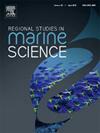Microplastic contamination in the gastrointestinal tracts of larval fish assemblages from coastal waters in southwestern Taiwan
IF 2.1
4区 环境科学与生态学
Q3 ECOLOGY
引用次数: 0
Abstract
Microplastics (MPs) are widespread in coastal seas, posing risks to marine life. Planktonic fish larvae and juveniles, essential for fish population sustainability, are particularly susceptible to MPs, environmental stress, and predation. However, the effects of MP ingestion on larval fish remain poorly understood. This study investigated MP ingestion in 169 larval and 4 juvenile fish from the coastal waters of Qieding, Taiwan. Gastrointestinal tracts were analyzed using alkali digestion, microscopy, and FT-IR analysis, revealing MPs in 21.39 % of samples at an average of 1.59 ± 0.90 MPs individual–1. A total of 59 MPs were identified across 20 fish species, with whipfin silver-biddy (Gerres filamentosus) showing the highest count (14 particles; average of 1.75 ± 0.00 MPs individual–1). Polyethylene terephthalate (PET) was the most common polymer (44.07 %), while fibers constituted the majority of particles (89.83 %), primarily transparent (54.24 %). Nearly half of all MPs measured between 1 and 5 mm. MPs were positively correlated with fish size (R² = 0.038, p = 0.009), and more advanced developmental stages, such as juveniles, showed a significantly higher incidence of MPs (p < 0.001). This trend indicates that MPs are more frequently ingested by juvenile or larger fish larvae. These findings provide essential insights into MP contamination in Taiwanese waters, highlighting potential impacts on the health of planktivorous larval fish and marine ecosystems.
求助全文
约1分钟内获得全文
求助全文
来源期刊

Regional Studies in Marine Science
Agricultural and Biological Sciences-Ecology, Evolution, Behavior and Systematics
CiteScore
3.90
自引率
4.80%
发文量
336
审稿时长
69 days
期刊介绍:
REGIONAL STUDIES IN MARINE SCIENCE will publish scientifically sound papers on regional aspects of maritime and marine resources in estuaries, coastal zones, continental shelf, the seas and oceans.
 求助内容:
求助内容: 应助结果提醒方式:
应助结果提醒方式:


